Our Aggro Overload Shaman deck list guide goes through the ins-and-outs of this explosive Shaman build for the Rise of Shadows expansion! This guide will teach you how to mulligan, pilot, and substitute cards for this archetype!
Introduction to Aggro Overload Shaman
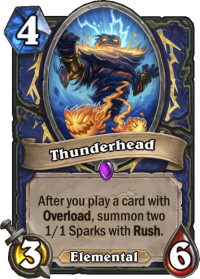
Aggro Shaman is a deck with a long history in Hearthstone. The archetype has seen many changes from the Mech builds during Goblins vs Gnomes in 2014 to the first Overload lists built around Tunnel Trogg during League of Explorers in 2015. It re-emerged from slumber during The Boomsday Project with the introduction of Thunderhead, and gained more power during Rastakhan’s Rumble with Spirit of the Frog. It was not very strong in the early days of Rise of Shadows, but with the meta shifting away from weapon removal and a buff to Thunderhead (from 3/5 to 3/6), this Doomhammer-wielding deck is ready to rumble once again!
The main plan of Aggro Shaman is to get in a bit of chip damage with minions, follow that up with Doomhammer and Rockbiter Weapon, and finish the job with direct damage spells such as Lava Burst. It is a straightforward aggro plan, but there are some tricks that the deck can pull off along the way: Thunderhead provides the means to rapidly generate tokens to control the board, and Spirit of the Frog can draw through the spells in the deck at a rapid pace. These small tricks make the deck interesting and fun to play.
Aggro Overload Shaman Deck List
This sample deck list is from WuLing, who piloted it to #49 Legend.
Check out alternative versions of this deck on our Overload Shaman archetype page!
Aggro Overload Shaman Mulligan Strategy & Guide
VS Fast Decks
Higher Priority (Keep every time)
- Thunderhead – Your main tool for gaining board control.
- Likkim – Three-durability weapon that can help maintain board control.
- Sludge Slurper – Powerful one-drop.
Lower Priority (Keep only if certain conditions are met)
- Zap! – Keep with Likkim or Thunderhead.
- Earth Shock – Keep against big Magnetic threats from Bomb Hunter or Mech Paladin.
- Spirit of the Frog – Powerful card draw engine, can be kept if you already have early plays available.
VS Slow Decks
Higher Priority (Keep every time)
- Unbound Elemental – A growing threat.
- Thunderhead – It is a strong minion, a threat even in control matchups.
- Sludge Slurper – Powerful one-drop.
- Spirit of the Frog – Card draw engine.
Lower Priority (Keep only if certain conditions are met)
- Doomhammer – Keep if you do not expect weapon removal, such as against Priest.
- Earth Shock – Keep against Priest.
Aggro Overload Shaman Play Strategy
The main strategy of Aggro Overload Shaman is to deal chip damage with minions, follow that up with Doomhammer and Rockbiter Weapon, and finish the job with direct damage spells such as Lava Burst. In this section, we will discuss some of the general ideas and tricks used when playing the deck as well as specific approaches to aggro and control matchups.
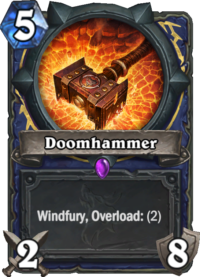
As the name implies, this is an overload deck, and it is crucial to manage your overload carefully. Plan your mana total ahead, so that you are not overloaded when you need to play specific cards. Doomhammer, for example, is often important to play as soon as possible, so you may not want to be overloaded heading to turn five – with the exception of having Thunderhead + Zap! against tokens on turn four, as it is such a crucial play.
You often want to roll a Totem from your Hero Power before using your direct damage spells, because a Wrath of Air Totem can help you find some important spell damage. Take your overload into account here as well, as sometimes you need to send one Lava Burst to face before the main damage turn in order to have exactly the right amount of mana available.
Try to deal damage with minions and weapons first and use your direct damage spells later in the game. If the opponent is able to set up Taunt minions on your way, you can still reach face with direct damage spells or Earth Shock – or sometimes by using the direct damage spells to clear the taunt minions, if you will be able to deal more damage with minions and weapons that way. Try to optimize for the total damage you can deal in a game.
You gain Windfury when you play Doomhammer, so it is possible to first hit one more time with Likkim and then equip Doomhammer to get an extra attack. This also works with Rockbiter Weapon, so a hit from activated Likkim followed by a hit from Doomhammer with Rockbiter Weapon buff on both deals a total of 11 damage instead of the 10 you can usually do with Doomhammer alone.
Thunderhead is crucial for board control. Because it generates two 1/1 Rush tokens for each overload spell, it is easy to run out of board space with Thunderhead, unless you pay attention to how you spend your tokens. For example, I have sometimes used Lightning Bolt on a Mirror Image token just so that I can trade off some of my tokens to free up board space and get the full value of my overload spells together with Thunderhead.
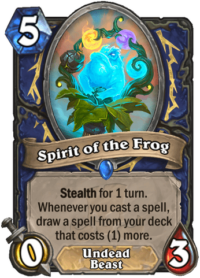
Spirit of the Frog is another key piece. Plan your draws in advance, because drawing a chain of spells with the Spirit is important. Spirit of the Frog has Stealth for one turn when played, so sometimes you can just play it, and start drawing on the following turn. Be wary of opponents who can clear minions that are in stealth, such as Warriors with Dyn-o-matic.
Zilliax is the most popular card in the game and deserves a special mention. While it does not fit into this deck, you can expect to meet lots of them on the ladder. Remember that much of your damage comes from spells and weapons, so you do not necessarily need minions in the mid-game. Therefore, sometimes you can close the Zilliax out from the opponent by trading all of your minions and all of their Mechs away, so that Zilliax cannot Rush into anything. At other times, you may want to consider how you will answer Zilliax: sometimes the healing does not matter and you just kill it with a weapon or minions, but at other times having access to Earth Shock or Zap! can be important to effectively deal with the small menace.
Some variants of the deck use some of the Shaman Legendary cards to enable more tricks. The downside is that these cards are typically useless alone and need to be combined with other cards in order to influence the game. A more straightforward approach without the Legendary cards can sometimes be more effective, depending on the meta.
- Electra Stormsurge is the most common Legendary card to include. Its traditional use is as a finisher, because Electra + Lava Burst deals 10 damage for six mana, and Electra + Rockbiter Weapon adds 12 damage to a Doomhammer. In some ways, it is like having three copies of Lava Burst or Rockbiter Weapon in the deck. Electra can also be effective with Earthen Might, which can turn Electra into a 7/7 and give you two random Elementals. Electra and Feral Spirit can give you four Taunt minions on the board. Finally, some people have experimented with Electra and Haunting Visions, as the combo allows you to discover two spells and then cast a spell with a six-mana discount.
- Zentimo is another popular choice, even though it does not deal direct face damage. Zentimo can buff up to three of your minions with Earthen Might, or deal damage or silence up to three of the opponent’s minions with direct damage spells or Earth Shock.
- Krag'wa, the Frog is less common than the other two, but it can help in slow matchups. Getting all of your spells from the previous turn back into your hand can keep the deck going, but can be difficult to combine with the overload from many of your spells. Krag’wa is mostly an anti-control tech card.
Some variants of the deck also use Underbelly Angler for potential Murloc generation. If you play a deck like that, remember that it is not a Murloc deck, and you should be liberal in your use of Underbelly Angler: playing it at the start of the game is usually correct, as it will soak some premium removal even if you have no other Murlocs in hand. If you find the card later in the game, try to get random Murloc value from it.
VS Aggro Decks
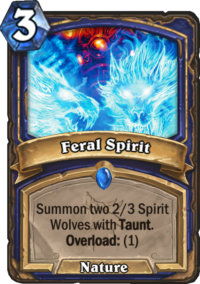
Against aggressive decks, you tread a fine line between aggression and defense. Thanks to the power of Thunderhead, you can often wrestle control of the board, and in combination with Feral Spirit, you have some defensive capabilities to play the control role. However, not all hands line up like that. Sometimes, your hand forces you to be the aggressor and sometimes it forces you to be the defender.
Aggro mirrors often end with very small margins: it is typical for one player to have lethal just one turn before the other one would have it. Therefore, each point of damage counts. The decisions on when to trade and when to go face are difficult in aggro mirrors, because there is no room for errors.
Make a plan depending on your hand and your opponent: Against decks with low reach, it can be right to use Doomhammer for board control and let your minions deal face damage. Against decks with poor removal capabilities, it can be right to race them and rely on Thunderhead tokens and Feral Spirit to provide enough defense that you reach the finish line first.
VS Control Decks
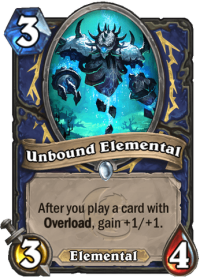
Against control decks, your role is clear, you are always the aggressor.
Try to make the most out of your big threats Unbound Elemental and Thunderhead. Set up board states so that they are difficult to remove. Against Warrior, for example, try to keep them out of reach of Militia Commander and Dyn-o-matic, and try to keep the Warrior’s armor total low so that a Shield Slam cannot deal with them. If you’re able to get Unbound Elemental growing well, you may sometimes even want to avoid playing other minions on the board to play around Brawl.
You need juice against control decks, and no card gives you more stuff than Spirit of the Frog. Plan your use of it carefully. Some decks may be able to remove it even though it is in stealth, such as Warrior with Dyn-o-matic or Brawl, whereas others cannot clear it until it becomes visible. When you’re on the Coin, you can use that to draw a one-mana spell with Spirit of the Frog and get your drawing chain started.
Make trades to protect your key minions if you still need damage from them. Other than that, hit face and let the opponent do the trading.
Aggro Overload Shaman Card Substitutions
Aggro Overload Shaman is a relatively cheap deck. The mandatory expensive cards are Epics, and while there are several builds that use Legendary cards as well, none of them are absolutely necessary.
- Doomhammer cannot be replaced in this archetype. The deck relies on Doomhammer and Rockbiter Weapon combo a lot and nothing can replace those.
- Thunderhead cannot be replaced in this archetype. The buff to Thunderhead was instrumental in bringing the archetype back to the meta, as Thunderhead is able to help you win the board in many games.
Leave a Reply
You must be logged in to post a comment.

This deck was the same as Exigo using? I don’t know his deck but I know that he is an Aggro user and I like to copy his decks coz’ his deck leads him to win the WCG Hearthstone Category.
I really like the inclusion of 2 Underbelly Angler for three reasons. 1) the deck lacks early minion chip damage which can help you more easily close out games with burn later, 2) playing Angler on turn 2 can trick your opponent into thinking you are murloc shaman, which may cause them to over commit resources in order to remove it (even though you likely don’t have a murloc card to play the following turn), and 3) against slower decks you can hold onto Angler and Sludge Slurper for a full board refill.
I’ve played this deck a few times and found Doomhammer to be to slow… sometimes I had a linkin and two doomhammers on my hand…totally useless
I’m already runnin’ this very deck. And love it immensely.
I really like this build. It’s the baseline of Aggro Overload Shaman: every card is included in two copies, there is nothing too fancy, it’s just the goods. It is a great place to start and then tech in some of the Legendaries or some tech cards depending on the meta.
Totally agree with you on that.
Great guide as always OLD GUARDIAN. I was wondering if Hench Clan Thug could fit the deck since it synergies well with Likkim, Rockbiter(alone) and especially Doomhammer.
The synergies are not reliable enough. You generally do not want to use Rockbiter alone, and you cannot always find Likkim. By the time you get to Doomhammer, you are often going face to race to the finish line. There are some situations where you control the board with Doomhammer, but those are not common enough to really benefit from the Thug.
So Likkim is the most likely to go along with thug, but since you have just 2 of them it is not relialable enough. Thank you for you answer Old Guardian.